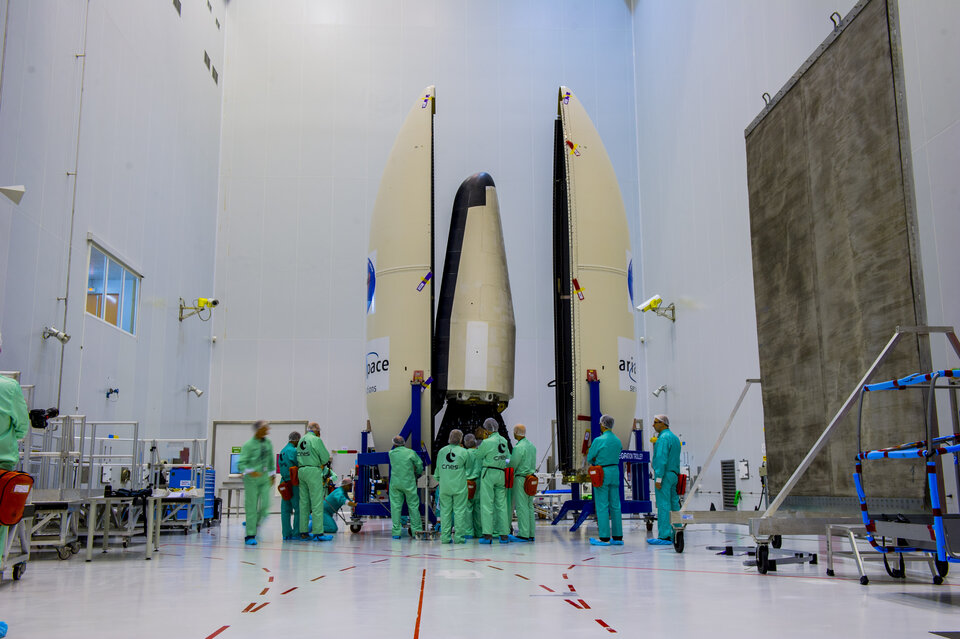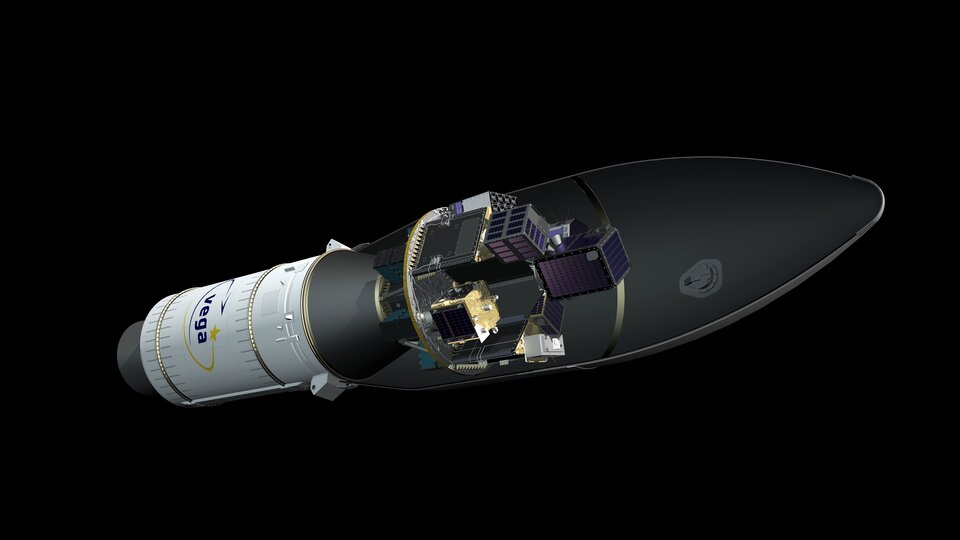12.02.2022

Ten years ago this week, 13 February 2012, ESA opened a new era of independent access to space with the flawless inaugural flight of its small launcher Vega. Flying from Europe’s Spaceport in French Guiana, Vega has gone on to earn a reputation for precision and versatility in anticipation of a more capable version, Vega-C.

Placing medium-sized satellites into the low Earth polar orbits that are ideal for scientific and Earth observation missions – about 1430 kg to 700 km – is Vega’s trademark capability. But the vehicle has also delivered an ESA science mission to deep space – the gravitational wave detector demonstration mission, LISA Pathfinder – and followed the equatorial flight path needed for an experimental IXV ‘lifting body’ payload that paved the way for a European launchpad-to-runway space transportation service, with ESA’s uncrewed Space Rider vehicle.
Vega has also mastered ‘ride sharing’, to cost-effectively put multiple satellites into orbit on a single flight. This launch vehicle has set the stage for the imminent first flight of a bigger, more capable variant, Vega-C – delivering more payload and greater flexibility for the same cost. And, with its industrial partners, ESA is developing a further evolution, Vega-E, to reduce programme costs while boosting performance.
For Vega’s inaugural flight, VV01, the Italian space agency, ASI, supplied the principal payload, LARES (LAser RElativity Satellite).
VV01 capped more than a decade of work on a small vehicle to complement ESA’s heavy lifter, Ariane 5, and the upcoming Ariane 6. ESA and Arianespace partly filled that gap by bringing the medium-lift Soyuz rocket to French Guiana from 2011.
But the breakthrough was Vega which became an ESA programme in 2000. Seven Member States contributed: Belgium, France, Italy, the Netherlands, Spain, Sweden and Switzerland. ESA, with the technical support of the Italian and French space agencies, and about 40 industrial companies coordinated by the prime contractor Avio, made this enormous challenge a reality.
About 1000 individuals were involved in the Vega development. “Vega is above all a human adventure built on a great European team, built on competence and cooperation, relying on outstanding dedication and effort,’’ said Stefano Bianchi, Head of Flight Programmes. “For all the engineers and operators who worked so hard to prepare the launch, the 13 February 2012 is a day that will always remain deeply rooted in their memories, as it is in mine.’’
Vega combines three solid-fuel stages with a fourth, liquid-fuelled stage. Solid fuel motors cannot be throttled, stopped or restarted – after ignition they burn at full-power until the fuel runs out – but they provide exceptional liftoff thrust without the tanks, fuel pumps and fuel handling infrastructure needed for liquid propellants. These economical motors can be manufactured and fuelled in advance to be safely stored until needed for launch.

The liquid-fuelled fourth stage provides fine control of position thanks to its stop-start-throttle capabilities, so Vega can accurately deliver single or multiple payloads to different orbits on one launch. This flexibility was demonstrated on flight VV16 in September 2020, when Vega first carried its Small Spacecraft Mission Service (SSMS) dispenser for light satellites. The ride share mission orbited seven microsatellites and 46 cubesats.
Continuous development

Since 2012, Vega has played a fundamental role in the space transportation sector and its ongoing development and future evolutions, together with Ariane, will further increase competitiveness beyond 2025. This is a response to the rapid growth of worldwide competition and offers a family of configurations based on common building blocks.
While Vega team members will surely take a moment today to reflect on a memorable decade, their focus is on the future – and the inaugural flight of Vega-C.
“Vega-C is now in the last phase of its qualification – a crucial step towards its inaugural flight,’’ commented Renato Lafranconi, Vega Programmes Manager. “Its development is driven by the rapidly growing worldwide competition in the Space Transportation sector which requires the continuous improvement of the Vega launch system versatility and competitiveness to ensure its sustainability.’’
Like Vega, Vega-C features three solid-fuel stages and a liquid-fuelled fourth stage. But Vega-C brings two great improvements. One is an extra 800 kg payload capacity – an increase of more than a third, to about 2.2 tonnes – but for a similar launch cost.
Vega-C features a new, more powerful first stage, P120C, based on Vega’s P80. Atop that is a new second stage, Zefiro-40, and then the same Zefiro-9 third stage as used on Vega. The new AVUM+ fourth stage can remain operational in space for longer than Vega’s AVUM, to enable extended missions.
With its larger main stages and bigger fairing, Vega-C measures 34.8 m high, nearly 5 m taller than Vega.
Equally important is another Vega-C innovation. Its P120C first stage will do double service, with either two or four of these acting as strap-on boosters for Ariane 6. By coordinating Vega-C and Ariane 6 development, ESA and its partners are realising a strategy of continuous, agile development. Vega-E, for example, is being readied to add another 20% payload capability while reducing costs, from as soon as 2025.
ESA’s Director of Space Transportation Daniel Neuenschwander observes, “Major ongoing development programmes with Ariane 6 and Vega-C will allow Europe to maintain its independent access to space, which is a strategic priority in a world where technology, business and politics move very quickly.”
“We have to keep pushing forward, to make sure Europe is ready for the future.”

